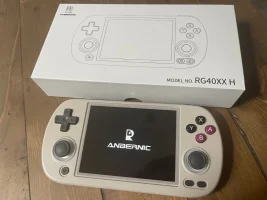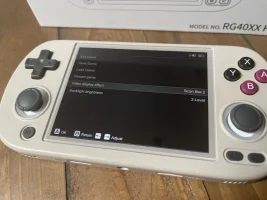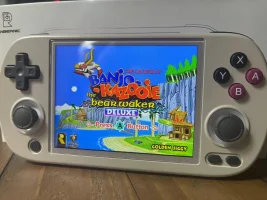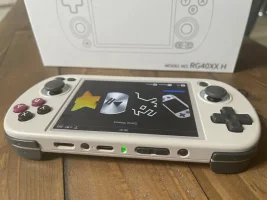General Information
This comprehensive review examines the RG40XX H's key features, including its 4-inch IPS display, build quality, and emulation capabilities. We test its performance across multiple retro gaming systems, evaluate the user interface, and assess the available custom firmware options. Our detailed analysis helps you decide if this budget-friendly retro handheld meets your gaming needs.
Design and Build Quality
Taking a significant departure from their previous designs, Anbernic has reimagined their handheld lineup with the RG40XX H, introducing a sleeker, more refined form factor that immediately catches the eye.
4-inch IPS Display
The centerpiece of the RG40XX H is its 4-inch IPS display with a resolution of 640x480. This fully laminated screen delivers impressive clarity and reduces glare significantly. While the pixel density might not be the highest in its class, the display produces sharp text and vibrant images. The screen's contrast levels are notably improved compared to previous models, though some units may exhibit minimal light bleed in the top left corner – a minor issue that's barely noticeable during actual gameplay.Ergonomics and Comfort
The RG40XX H introduces a curved shell design that marks a significant evolution in Anbernic's approach to ergonomics. At just 1.6cm thick and weighing 205g, the device strikes an excellent balance between portability and comfort. The rounded edges and thoughtfully contoured back allow your fingers to rest naturally along the sides, making extended gaming sessions notably more comfortable than its predecessors.Button Layout and Quality
The control scheme on the RG40XX H showcases several noteworthy improvements:- Analog Sticks: Feature customizable RGB backlighting with 16 million colors and multiple lighting effects. While the sticks are highly responsive, they do have relatively short travel distance.
- D-pad: Delivers near-flawless performance with excellent tactile feedback and flexibility, positioned optimally for extended gaming sessions.
- Face Buttons: High-gloss ABXY buttons sit slightly raised from the shell, featuring bouncy membrane switches that provide satisfying feedback without being overly clicky.
Build quality is remarkably solid despite the plastic construction, reminiscent of Nintendo's DS line. The shell demonstrates impressive durability and passes the shake test with minimal internal rattling. The dual speaker setup on the bottom delivers clearer mid and high ranges compared to previous models, and the thoughtful placement of dual SD card slots (one for OS, one for ROMs) adds to the device's versatility.
One notable consideration is heat management. The RG40XX H tends to run warmer than some competitors, particularly during extended gaming sessions. While this might be a deliberate design choice to protect internal components, it's something to be aware of during longer play periods.
Performance and Emulation
Powered by the Allwinner H700 chipset and 1GB of RAM, the RG40XX H delivers varying levels of performance across different gaming generations. Let's dive into its capabilities and limitations across various gaming platforms.
Supported Systems
The RG40XX H handles retro gaming across multiple generations with varying degrees of success. The device excels at running:- Classic 8-bit and 16-bit systems (NES, SNES, Game Boy, Game Boy Color)
- 32-bit systems (PlayStation 1)
- Sega systems (Master System, Genesis/Mega Drive)
- Arcade systems (MAME, Neo Geo)
- Nintendo DS (via DraStic emulator)
- Select Dreamcast and N64 titles
Frame Rates and Playability
The emulation performance varies significantly depending on the system being emulated. 8-bit and 16-bit content runs flawlessly, with perfect frame rates and responsive controls. The device particularly shines with 4:3 content, which looks impressive on the 4-inch display.PlayStation 1 games perform admirably, maintaining stable frame rates across most titles. Nintendo DS games, while appearing slightly blurry, run surprisingly well through the DraStic emulator, with the R2 button cleverly mapped for screen selection and the left analog stick handling stylus controls.
More demanding systems show the device's limitations. N64 emulation presents mixed results, with transparency issues affecting visual quality regardless of the emulator choice (Parallel or Mupen64plus_next). Games like Wave Race 64 showcase these inconsistencies, particularly with ROM hacks sometimes failing to launch.
Dreamcast performance has improved thanks to optimized Flycast emulation, though analog stick sensitivity issues can affect gameplay. Silent Scope, for instance, requires careful control remapping for optimal playability. PSP emulation manages simpler 2D titles like Patapon and LocoRoco adequately, but more demanding 3D games like God of War: Chains of Olympus and GTA: Vice City struggle to maintain 30 FPS.
The device also handles various ports impressively, with Quake, Wolfenstein, and even GTA3 running surprisingly well. However, the 1GB RAM limitation becomes apparent when pushing the system with more demanding titles.
Heat Management
Temperature management is a notable consideration with the RG40XX H. The device generates noticeable heat on the right side where the H700 chipset resides, particularly during extended gaming sessions or when running more demanding games. While the heat isn't severe enough to cause discomfort, it's most noticeable during:- Extended PSP gaming sessions
- Multiple Dreamcast games
- Intensive N64 titles
The thermal management system represents a reasonable compromise between performance and heat dissipation, especially considering the device's budget-friendly price point. While the warming is noticeable, it's a fair trade-off for the level of emulation capability offered.
Software and User Experience
The software experience on the RG40XX H presents a fascinating mix of stability and flexibility, offering both newcomers and experienced users multiple paths to customize their gaming experience. During our extensive testing, we've found that the device's software ecosystem has matured significantly, though it's not without its quirks.
Stock OS and Interface
The RG40XX H ships with Anbernic's latest 64-bit Linux-based operating system, which marks a significant improvement over previous iterations. The interface is straightforward, featuring a clean menu system that categorizes games by platform. We found navigation to be intuitive, with quick access to essential functions through the menu button.The stock OS includes several thoughtful features:
- Built-in game scraping functionality
- Customizable display settings with shader options
- Quick save/load functionality
- Integrated media playback support
Custom Firmware Options
The custom firmware landscape for the RG40XX H has evolved rapidly since launch. We've tested multiple options, each offering distinct advantages for different user types:MinUI A minimalist interface that prioritizes performance and simplicity. We found it particularly appealing for users who want a straightforward, no-frills experience with faster game loading times.
Knulli Based on EmulationStation, Knulli provides a more feature-rich experience with:
- Enhanced theme support
- Built-in scraping capabilities
- Comprehensive system configurations
- Improved performance optimizations
Recent controversy surrounded Anbernic's inclusion of certain pre-configured ports in their stock firmware. We recommend users remove any questionable pre-installed content and properly purchase games they wish to play through legitimate channels.
WiFi and Retro Achievements
The integration of WiFi capabilities (supporting both 2.4GHz and 5GHz bands) opens up several exciting possibilities. During our testing, we found the RetroAchievements implementation particularly compelling. Here's our recommended setup process:- Initial Configuration
- Connect to WiFi through Settings > Network Settings
- Create a free RetroAchievements account on their website
- Access RetroArch settings within the device
- Achievement Setup
- Navigate to Settings > RetroArch Settings
- Enter your RetroAchievements credentials
- Enable achievement notifications
- Save configuration changes
Bluetooth 4.2 connectivity enhances the experience further, allowing wireless controller connections for multiplayer sessions. The wireless features work seamlessly with the stock OS, though some custom firmware options may require additional configuration.
The WiFi functionality extends beyond just achievements, enabling:
- Online game database scraping
- Theme downloads
- System updates
- Controller firmware updates
The software ecosystem represents a significant evolution for Anbernic, particularly with the shift to 64-bit architecture. While the stock experience provides a solid foundation, the availability of custom firmware options ensures that users can tailor their experience to their specific needs. The integration of online features through WiFi connectivity, especially RetroAchievements, adds a modern touch to classic gaming that we found genuinely enhancing the overall experience.
Conclusion
The Anbernic RG40XX H stands as a compelling budget retro gaming device that balances performance with affordability. Strong 8-bit and 16-bit emulation capabilities paired with excellent PS1 and DS performance make this handheld shine for classic gaming enthusiasts. The refined ergonomic design and high-quality display demonstrate Anbernic's commitment to user comfort, though heat management during demanding games remains a notable consideration.
The device's mature software ecosystem, featuring both stock and custom firmware options, provides flexibility for both newcomers and experienced users. While N64 and Dreamcast performance shows room for improvement, the RG40XX H delivers remarkable value through its comprehensive feature set, dual SD card system, and WiFi capabilities. This handheld proves that budget-friendly retro gaming doesn't require significant compromises, making it a worthy choice for players seeking an accessible entry point into portable retro gaming.





